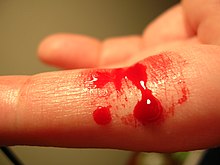Radical 143
| 血 | ||
|---|---|---|
| 142 ⾍ ◄ | 143 | ► ⾏ 144 |
| Pinyin : | xuè (= blood) | |
| Zhuyin : | ㄒ ㄩ ㄝ ˋ | |
| Hiragana : | ち chi | |
| Kanji : |
血 偏 chihen (= radical blood) |
|
| Hangul : | 피 | |
| Sinocorean : | 혈 (= blood) | |
| Codepoint : | U + 8840 |
|
| Stroke sequence : |
|
|
Radical 143 , meaning " blood ", is one of 29 of the 214 traditional radicals in Chinese script that are written with six strokes.
With 8 character combinations in Mathews' Chinese-English Dictionary, there are very few characters that can be found under this radical in the lexicon.
The radical "Blood" takes only in the traditional characters - list of traditional radicals consisting of 214 radicals 143. position. It can be found in a completely different place in modern abbreviation dictionaries. In the New Chinese-German Dictionary from the People's Republic of China, for example, it is in 181st place.
The seal form shows a bowl ( 皿 ) in which a short horizontal line indicates that there is a liquid in it: blood. The radical 血 (xie) occurs as a sound carrier in signs such as 恤 (= have mercy), 洫 (in: 沟 洫 = moat that separates fields from each other).
In the left position in the symbol, the last line of 血, the lower horizontal line, is executed as an ascending line as in 衅 (= dispute, original meaning: everyday objects smeared with the blood of pets).
Character combinations ruled by radical 143
| Strokes | character |
|---|---|
| + 0 | 血
|
| + 3 | 衁 衂
|
| + 4 | 衃 衄
|
| + 5 | 衅
|
| + 6 | 衆 衇 衈 衉
|
| +15 | 衊
|
| +18 | 衋 |
In the Unicode block Kangxi radicals the radical 143 is coded under the code point number 12.174 (U + 2F8E).
literature
- Edoardo Fazzioli : Painted Words. 214 Chinese characters - from picture to concept . Marixverlag, Wiesbaden 2004, ISBN 3-937715-34-7 , p. 168 .
- For detailed references, see List of Traditional Radicals: Literature
Web links
- Xiù cai.oai.de (PDF; 1.72 MB) Explanation of Radikal 143 on page 121

